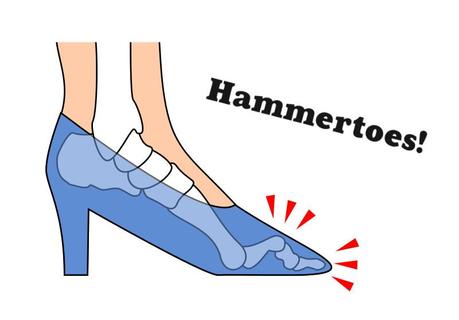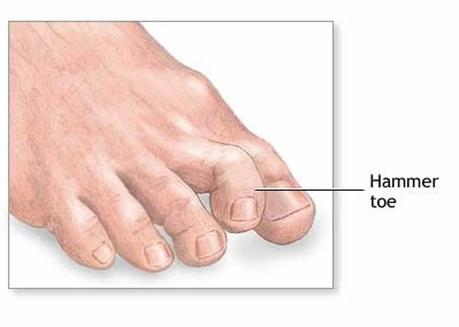If you're familiar with Soft Star's footwear philosophy then you probably already know we're not fans of shoes that place form over function. We understand that many women wear high heels and tight shoes as fashion choices, but we also see the damaging effects these shoes have on our customers' feet. One of the most common foot problems that women suffer is hammertoe.
Hammertoe can occur when feet are crammed into shoes so tight that the front of the toes are pushed against the front of the shoes for prolonged periods of time. One or more toes then remain bent with the middle knuckle pointing up, even when shoes are taken off. If the condition is left untreated and tight footwear is continually worn, these bent toes can become so rigid that they can no longer straighten out on their own. While any shoes that are too tight can lead to this condition, high heels seem to be a big culprit since the elevated ankle causes more weight to push the toes forward. This may explain why the condition affects more women than men.

Common problems associated with hammertoes are swelling, corns and pain on the top or bottom of the foot. Extreme cases of hammertoes may require surgery to correct, but the good news is that many cases can be corrected and treated before it gets to that point. If you notice signs of hammertoes in your feet, try some of these suggestions:
If you've worn tight shoes for many years and think you have hammertoes that require more care, then we strongly recommend seeking help from a medical professional. An experienced podiatrist may be able to offer you a treatment plan specific to your needs. The sooner a foot problem is treated, the easier it is to correct.
Our friend and podiatrist, Dr. Ray McClanahan, has a lot of experience treating patients with hammertoes. He has also written this helpful article on the subject, which we're happy to share for anyone looking for more information:
Hammertoes
By Ray McClanahan, D.P.M.
Hammertoes are a type of crooked toe that involve unnatural contracture, or bending, of your toes. In most cases, a hammertoe is characterized by a toe malposition in which the end of your affected toe points down and the first joint of your same toe—your proximal interphalangeal joint—points up. This crooked toe syndrome usually leads to rubbing within your shoe and pain. A hammertoe resembles an upside-down letter v when viewed from the side. This crooked toe syndrome most commonly affects your second to fifth toes, though it may also affect your big toe. This health problem is more commonly experienced by women than men.

Condition Information
People who have painful hammertoes visit their podiatrist because their affected toe is either rubbing on the end their shoe (signaling a contracted flexor tendon), rubbing on the top of their shoe (signaling a contracted extensor tendon), or rubbing on another toe and causing a painful buildup of thick skin, known as a corn.
Hammertoes can be flexible or rigid. Hammertoes often start out flexible and become rigid over time as your toe becomes accustomed to its crooked position. Flexible hammertoes are less serious than rigid hammertoes, as they can be easily diagnosed and treated in their initial stages. Flexible hammertoes are named as such because your affected toe still possesses some degree of movement.
Rigid hammertoes are toes that do not move when you try to bend them. Rigid hammertoes are particularly common in people who have advanced arthritis or among people who avoid appropriate care for a prolonged period. Tendons in your rigid hammertoe have become tight, and your joints may be misaligned and immobile. Rigid hammertoes may require surgery to help correct if more conservative strategies fail to resolve your problem.
Causes and Symptoms
Footwear can contribute significantly to the development of hammertoes. Shoes that are too small force your toes into a curled position. Over time, your toe tendons adjust to this positioning, causing your toe or toes to hold a hammered shape. Athletes may be especially susceptible, because of the increased forces on the toes from shoes that are too small or tight. Heel elevation in footwear is also problematic, as it causes your toes to be pushed into the shoe’s toe box. Heel elevation additionally contributes to muscle imbalance. A common example of this is when your Achilles tendon—the tendon at the back of your leg that attaches your calf muscles to your heel bone—is too tight, causing the tendons on the top of your foot that attach to your toes to work too hard and hold your toes in an unnatural, elevated position.
Pain on the bottom of your foot, especially under the ball of your foot, is one of the most common symptoms associated with hammertoes. Other common signs and symptoms of hammertoes include:
- Pain at the top of your bent toe from footwear pressure
- Corns on the top of your bent toe
- Redness and swelling in your affected area
- Decreased joint range of motion in your affected toe joints
Treatment
Your podiatrist may recommend conservative treatment techniques for your hammertoes based on your foot structure, which will likely involve removing any thick, painful skin, padding your painful area, and recommending for you shoes that give your curled toes adequate room. Conservative care strategies for this health purpose may also involve the use of Correct Toes, our toe straightening and toe spacing device.
Your podiatrist may recommend a surgical procedure if your hammertoes are not helped by the conservative care methods listed above. Surgery for hammertoes is performed to help straighten your crooked toe. Your surgery will be performed in your podiatrist’s office or at a hospital, depending on the severity of your hammertoe. A metal pin is sometimes used to help your affected toe maintain its straight position during your recovery.


